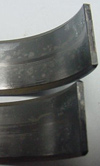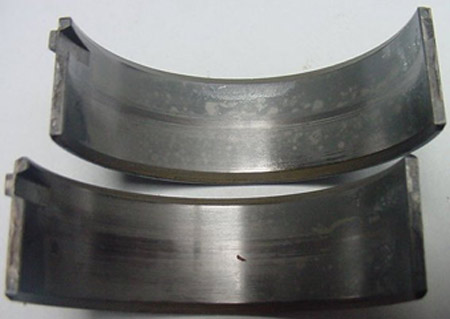Coated bearing bores on con rods
 There have been brief mentions in the pages of Race Engine Technology of the possibility of coating the big-end bore of con rods directly with the soft metal bearing coatings that we find on the surface of bearing shells. Further mentions have appeared in previous RET-Monitor articles on the subjects of coatings and con rods.
There have been brief mentions in the pages of Race Engine Technology of the possibility of coating the big-end bore of con rods directly with the soft metal bearing coatings that we find on the surface of bearing shells. Further mentions have appeared in previous RET-Monitor articles on the subjects of coatings and con rods.
Many years ago, this was indeed the way it was done, with the bearings manually 'scraped' by hand to achieve the correct size. Progress in the production of bearing shells has thankfully relieved us of the burden of manual bearing scraping, although many of us will possess a set of bearing scrapers that double as fantastic deburring tools. At that time, the bearing material was applied to much greater thicknesses and the bearings wouldn't work anything like as well as they do today. Part of the reason for the longevity and load capacity of modern shell bearings comes from the newer materials, but much also comes from the very thin coating and the precision with which these parts are made.
So, the first point to be established is whether it is possible to accurately deposit bearing coatings directly to the con rod and cap. After having discussed this with more than one company, this is definitely the case, although it is currently much more expensive than producing shells.
Does it work? Apparently yes. There is no technical reason that it shouldn't, and history also suggests that it should work fine. Racing companies have looked seriously enough at this idea in the past to have made and tested rods, at great expense.
The technical advantages are numerous - there are no features required to prevent bearing rotation, the rods can be made smaller and lighter, the bolts can be brought closer to the big-end axis and are therefore subject to lower bending stresses for the same applied service loads. During the period when there were no restrictions on crank centreline height from the base of the engine in Formula One racing, an advantage could be found by dispensing with the bearing shells and reducing this dimension to a minimum. On a 90º vee engine, the rod bolt (or nut) is generally the part of the rod locus that is the lowest part, and thus limits how close the crank axis can be to the lowest inner surface of the sump.

The reason why con rods with bearing coatings directly applied are unlikely to be seen widely in motor racing in the near future is one of economics. The accuracy required for the manufacture of the con rod bore would be increased, and the mechanical masking necessary to prevent coating being applied to areas other than the bearing bore would be expensive to produce and use. The very obvious sticking point is that when the bearing wears or shows signs of distress, the rod may well be scrap, or at least require serious re-work. To run engines with bearing coatings directly applied to the big-end bore would require a large increase in the inventory of con rods held by racing companies.
However, for production engines, it is very likely that this process will come to be the norm. With large production quantities, engines able to run for the life of the vehicle without disassembly and rebuild, and reduced parts inventory, the possibility to save money is very real indeed. The question of mechanical masking would be less important, as the costs would be amortised over a huge number of parts, and it is probable that the entire process would be automated.
Fig. 1 - In racing, we are unlikely to see the widespread use of con rods with bearing metals directly applied
Written by Wayne Ward